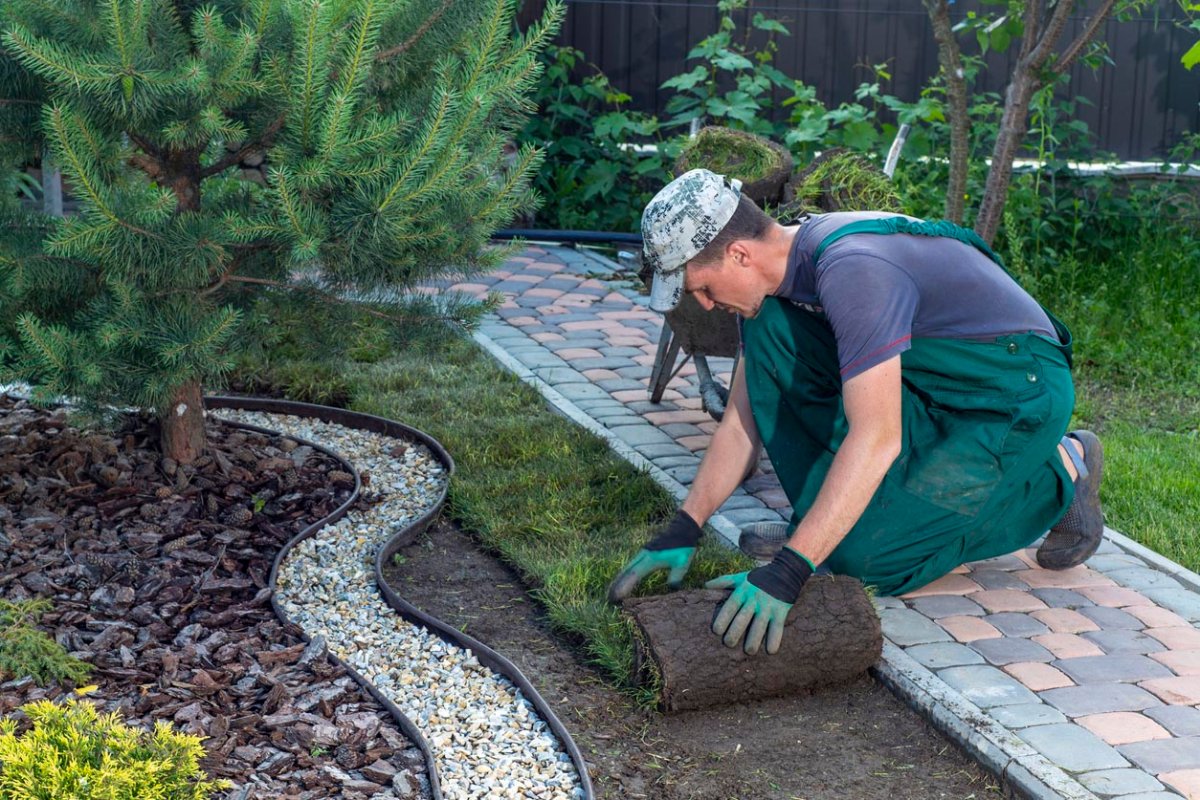We may earn revenue from the products available on this page and participate in affiliate programs. Learn More ›
A landscaping career can be ideal for anyone who loves the great outdoors, working with plants, and staying active. From lawn care to landscape design to hardscaping, there are many different paths for someone to take. When it comes to landscaping, the great news is that there are plenty of opportunities and steady demand for these services. With the range of landscaper services available, learning how to become a landscaper is as varied as the natural world itself. But for those wondering what landscapers do, it’s important to understand the different types of landscaping responsibilities available within the industry.
Before You Begin…

Before deciding on a career in landscaping, anyone entering the field will want to take into consideration the different types of careers and landscaping duties. Not all landscaping requires formal schooling; however, some of the career paths within landscaping—such as landscape architecture—require a person to have an undergraduate, or even graduate, degree from one of the best landscape architecture schools. For those who are interested in learning how to become a landscaper, it may be helpful to research exactly what the responsibility of a landscaper is, as well as the different careers available within the landscaping field and the salary that goes along with these careers.
Tips for Becoming a Landscaper
- Decide what aspect of landscaping to focus on, such a tree care, lawn care, or design.
- Research what schooling or certification will meet the landscaping job requirements.
- Dig into the local job market to see what type of companies may offer employment or apprenticeships.
- Start working to gain on-the-job experience.
- Consider the options between self-employment or seeking full-time work with a company.
STEP 1: Earn your high school diploma or GED while building your gardening skills.
Many landscaping companies require their employees to have, at minimum, a high school diploma or GED. Many high school students opt to take summer jobs working with a landscaping crew, which can help build important on-the-job skills for future full-time employment. And yes, spending the summer mowing neighbors’ lawns counts toward this type of skill-building. Working at a garden center or plant nursery is another way to gain valuable plant knowledge and experience. Those who gravitate toward landscaping careers tend to have a green thumb and a love of gardening. While these are not requirements, they make sense for anyone considering a career path working with plants and natural materials. Additionally, being in good physical shape is an advantage, since many landscaping jobs (especially at the entry-level) require the ability to lift 50 pounds and work outside in all types of weather.
STEP 2: Look into trade school or consider getting a degree in landscape architecture, horticulture, or a related field.
Though becoming a landscaper in general does not require a specific degree, some landscaping careers will benefit from formal education, while others require it. For example, becoming a certified arborist can boost salary and the chances of being hired, but tree care companies are not likely to explicitly require it. Landscape design requires knowledge of computer-based design programs, as well as an understanding of materials, estimates, and plant growth over time. Many of the best online landscape design courses are aimed at teaching a skilled landscaper the finer art of landscape design.
According to the U.S. Bureau of Labor Statistics, the average salary in the United States for landscapers and groundskeepers is $17.92 per hour, or $35,890 annually. This can grow over time as skills and experience increase. A self-employed landscaper’s salary can bump up from the national average of $27,550 to $48,530 or more with the addition of landscape design skills, with the addition of landscape design skills, as those who have these skills in addition to landscaping knowledge can command a higher hourly rate.
Other professions, such as botanist, agronomist, or landscape architect, require workers to hold a college degree and pass a certification test. Many community colleges offer associate degrees in horticulture, which can help job seekers have a competitive edge over others in the field. Looking into the different requirements for the various landscaping paths will give prospective landscapers a clearer picture of the educational component.

STEP 3: Apply for an apprenticeship or entry-level landscaper position to continue building your skills and experience.
Would-be landscapers will benefit from an apprenticeship and on-the-job training, regardless of their schooling or education. This is in part because landscapers work with nature and natural materials, which are not always formulaic. For this reason, an apprenticeship to gain real-world experience is invaluable. Apprenticeships allow individuals to gain skills while providing experience, and they can help an those in this field decide whether they wish to take on a position of greater responsibility, such as crew leader.
For example, gaining employment with a tree care company before investing in becoming a certified arborist can allow budding landscapers to receive valuable on-the-job training. Kaustubh Deo, president of Blooma Tree Experts, a tree service company based in Seattle, Washington, reminds potential hires to climb their way up, literally. “The ideal [way to gain experience] is to go work as a groundworker for a company that has a tree pruning crew,” Deo explains. “While the arborists and climbers are at work, actually in the trees and pruning the limbs, you’re the person on the ground dragging these branches to the chipper and chipping them up. But importantly, you’ll learn how arborists prune trees, which is related to tree biology. It’s actually a very natural apprenticeship type role to go from this, a groundworker, to eventually becoming a climber and then eventually from there a certified arborist.”
STEP 4: Understand your state’s licensing requirements for landscapers.
Every state has different requirements for a landscaping license. Some states require the owner of the landscaping company to obtain a business license, but those who work for a landscaping company may not be required to have any special license. However, self-employed landscapers who want to strike out on their own will want to learn how to get a business license.
The process usually starts with an application through the local secretary of state business license office. Some states may require a landscape contractor license to be held by either individuals or businesses. Landscaping contractors may also be required to hold general liability insurance. Not all insurance requirements will be the same, either. For example, the best insurance for lawn care businesses (through NEXT Insurance or Thimble, for example) may be different for businesses that deal with stump removal or work with heavy equipment operation.
Additionally, landscapers may be required by their state to obtain a license or specific certification for the application of chemicals, including fertilizers, pesticides, and fungicides. This is to ensure that such chemicals are applied and disposed of safely. Failure to obtain this type of license can result in fines—or even a landscaping business being shut down.
Landscaping often involves driving a vehicle (such as a truck), so employers may require a driver’s license as a condition of employment. Some companies operate machinery, and a special license may be required for this as well. Landscaping businesses that have company vehicles will also need to purchase commercial auto insurance to cover their fleet against damage and to protect the company in the event of an accident or injury to others.
STEP 5: Consider getting certifications and specializing in certain areas of landscaping.
There are several different paths an aspiring landscaper can consider following, including lawn care, tree care, landscape design, sustainable gardening, working with native plants, becoming an irrigation specialist, and hardscaping. When deciding what area to specialize in, aspiring landscapers will want to take into account their existing knowledge, the local market trends, and the type of certification or investment that may be required to gain skills. The cost of landscaping can go up depending on a landscaper’s specialty skills, so in order to make a higher salary, it can be a good idea to specialize in a particular area.
Sara Abbass, owner of Sara Mairead Landscape Design in Northport, New York, encourages those entering the field to think about market saturation in their area, and what they can do to stand out. “Before I started my own landscape design company, I considered the industry where I lived and how I wanted to focus my time and talent,” she says. “In a saturated market, where every block has three different trucks from three different landscaping companies, some with ‘design’ services, I made a decision that I wanted to be competitive and provide a niche service focusing on sustainable design and landscape care, a service offered little in my geographical region.”

STEP 6: Purchase the basic tools and equipment you need to start working as a landscaper.
Ask any gardener and they’ll happily recommend the best pruning shears or weeders, so as a landscaper there may be a strong preference for a certain brand or type of equipment. From rakes to lawn mowers and chainsaws to rototillers, landscaping equipment and tools can be varied. Still, what may be necessary for a tree care company may not be required for a small-scale lawn care business.
Before investing in any tools or equipment, it’s a wise idea to do some investigating into the types of tools the best landscaping companies in the area may require employees to own. The type of landscaping jobs will dictate the tools and equipment required. Self-employed landscapers will need to make a bigger investment in tools and equipment up front, whereas someone joining a ground crew for an existing company may need nothing more than a pair of good work boots. Some companies request that employees have a reliable vehicle or work truck, while others have a fleet ready for employees to drive.
STEP 7: Find customers and build a portfolio to help showcase your work and build your client base.
Building a loyal client base is essential to finding landscaping jobs and growing any landscaping company. Joining an organization such as the National Association of Landscape Professionals can help landscapers stay on top of trends, topics of concern, and changes within the industry, which can in turn allow the landscape professional to cater to client needs better.
Ryan Farley, the CEO of LawnStarter (an aggregate site that matches customers with lawn care and landscaping professionals in their area), reminds landscapers new to the industry that those first few clients can be key to growing their business. “When you’re first starting out, the real key to getting a successful landscaping business going is to cultivate great relationships with your first few clients. There are a few reasons for this. First of all, you’ll want to have some quality photos of successful jobs to use for advertising. Your customers will also be some of your best marketers, especially since most landscaping businesses grow locally,” he explains. “Recommendations and referrals are the lifeblood of a successful landscaping business. At some point, you’ll hopefully grow large enough that you won’t have the time to give each customer your personal, undivided attention, but in the early days, it’s absolutely essential.”
Landscaping is an industry that encourages on-the-job training, so gaining skills while making an immediate income is one of the many perks of a landscaping career. Whether the desire is to pursue a landscaping career because of a green thumb and a love of plants or a deep desire to work independently—and outside—budding landscapers can turn their passion into a prosperous career.


